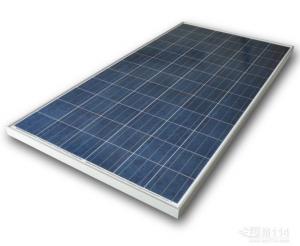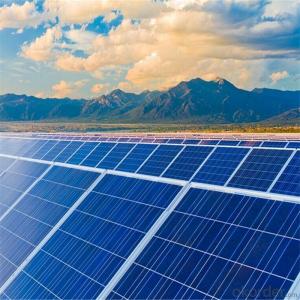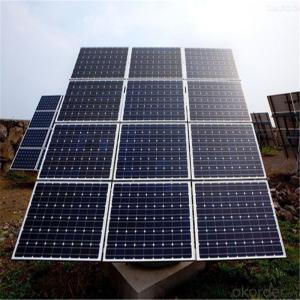115 Watt Bi-Facial Photovoltaic Poly Solar Panels
- Loading Port:
- China main port
- Payment Terms:
- TT OR LC
- Min Order Qty:
- 1000 watt
- Supply Capability:
- 500000 watt/month
OKorder Service Pledge
OKorder Financial Service
You Might Also Like
Specification
Instruction
1) Product name: solar panel / module
2) Solar cell: Mono-crystalline / Poly-crystalline / Amorphous
3) Tempered glass laminated with aluminum frame
4) Life time: 20 - 25 years
5) Temperature co-efficiency: A=+1,46mA B=-79mV, Rp/p=-0.43
6) Power specification at 1kW/m 2, AM 1, 5
7) Output cable: multi contact connectors
8) Construction:
a) Front: High-transmission 32mm tempered glass
b) Back: TPT
c) Encapsulant: EVA
9) Frame: aluminum
10) Certification: CE, TUV
Feature
1. High cell efficiency with high quality crystal silicon materials.
2. Long-term stability and reliability.
3. High Transmission, Low Iron Tempered Glass enhanced stiffness and impact resistance
4. Unique Aluminum frame designed for easy Installation and durable requirement
5. Advanced cell encapsulation materials to offer efficient protection
6. Outstanding electrical performance under high temperature and low irradiance conditions
7. Anti-aging of the EVA(polyethylene - vinyl acetate), high-performance crystalline silicon solar cells, good Weather resistance TPT (fluoroplastics composite membrane) by pyramid ,good Weather resistance and anti-UV, hail, water-proof capacity.Images
Images


Specification
ITEM NO.: | Poly 156*156 cell ,36pcs . Power 50Wp |
Maximum Power(W) | 80Wp |
Optimum Power Voltage(Vmp) | 17.5V |
Optimum Operatige Current(Imp) | 2.858A |
Open Circuit Voltage(Voc) | 21.6V |
Short Circuit Current(Isc) | 3.12A |
Solar Cell: | 156*156 Poly |
Number of Cell(pcs) | 3*12 |
Brand Name of Solar Cells | JA Cell, Bluesun Cell |
Size of Module(mm) | 790mm*515mm*28mm |
Cable & Connector Type | Pass the TUV Certificate |
Frame(Material Corners,etc.) | Aluminium-alloy |
Backsheet | TPT |
Cell Efficiency for 50W(%) | 15.10% |
Weight Per Piece(KG) | 4.7kg |
FF (%) | 70-76% |
Junction Box Type | Passed the TUV Certificate |
Tolerance Wattage(e.g.+/-5%) | 0~+3% |
Front Glass Thikness(mm) | 3.2 |
Temperature Coefficients of Isc(%) | 0.04 |
Temperature Coefficients of Voc(%) | -0.38 |
Temperature Coefficients of Pm(%) | -0.47 |
Temperature Coefficients of Im(%) | 0.04 |
Temperature Coefficients of Vm(%) | -0.38 |
Temperature Range | -40°C to +85°C |
Surface Maximum Load Capacity | 2400Pa |
Allowable Hail Load | 23m/s ,7.53g |
Bypass Diode Rating(A) | 12 |
Warranty | 100% of 10 years,80% of 25 years. |
Standard Test Conditions | AM1.5 1000W/m² 25 +/-2°C |
Packing | carton or pallet |
1*20' | 20 Pallets / 1600pcs |
1*40'STD | 40 Pallets / 3800pcs |
FAQ
We have organized several common questions for our clients,may help you sincerely:
1). What’s price per watt?
A: It’s depends on the quantity, delivery date and payment terms of the order. We can talk further about the detail price issue. Our products is high quality with lower price level.
2). Can you tell me the parameter of your solar panels?
We have different series of cells with different power output, both from c-si to a-si. Please take our specification sheet for your reference.
3). How do you pack your products?
We have rich experience on how to pack the panels to make sure the safety on shipment when it arrives at the destination.
4). How long can we receive the product after purchase?
In the purchase of product within three working days, We will arrange the factory delivery as soon as possible. The perfect time of receiving is related to the state and position of customers. Commonly 7 to 10 working days can be served.
- Q: Can solar panels be installed on a boat?
- Yes, solar panels can be installed on a boat. In fact, it is a popular and efficient way to generate electricity for various onboard systems, such as lighting, navigation, and charging batteries. Solar panels are lightweight, durable, and can be easily mounted on the deck or roof of a boat to harness solar energy and contribute to a more sustainable boating experience.
- Q: We are considering getting solar panels for our home just south of Birmingham, AL. We know a little and are trying to educate ourselves the best we can. But we are having a hard time finding anyone around this area. We have done the yellow page thing, and some quot;green places around town. But to no luck.....
- Any electrical contractor could likely install them, and there are several Internet businesses that sell solar panels. You likely have no place there to get the kind of large panels you need for a house. Look at your local regulations. Your utility may not allow grid-tie, so you may have to set up an off-grid system with batteries and use separate wiring or a transfer switch. One thing a lot of people neglect is hail protection. In Birmingham, you're likely to have large hail (larger than golf ball size) every couple of years in the spring. You need to work out a way of covering them in advance of severe weather. Most panels will take up to golf-ball size hail with no problem. DK PS, I've done this myself, and have considerably more information. Email if you're interested.
- Q: where I can find solar panel the has 4.8 volts? Like those solar walkway light or something that has 4.8 volts solar panel.Do you think I can get it from home depot?
- The other thing to do is to search for DIY solar chargers for more information.
- Q: How do solar panels withstand hail or other weather conditions?
- Solar panels are designed to be durable and can withstand hail and other weather conditions due to their sturdy construction and protective materials. The panels are made with tempered glass, which is highly resistant to impacts, including hail. Additionally, the panels are built to withstand high winds, heavy snow loads, and extreme temperatures. This ensures that they can endure harsh weather conditions without being damaged, allowing them to continue generating electricity efficiently.
- Q: Can solar panels be installed on a fire station or emergency services building?
- Yes, solar panels can be installed on a fire station or emergency services building. In fact, many fire stations and emergency services buildings have embraced solar energy as a sustainable and cost-effective solution. Solar panels can help these facilities generate their own electricity, reduce utility bills, and lower their carbon footprint. Additionally, the availability of rooftop space on such buildings often makes them suitable for solar panel installation.
- Q: Are there solar panel systems that I can plug directly into my house to help reduce my electricity bill? If so, are they very expensive? Any help would be greatly appreciated!
- As per the question, the answer is no. Solar panels are available, they are expensive, they can reduce your energy bill, you can get up to 30% of the expense back from your taxes, but they must be installed by a qualified electrician or solar panel installer to work properly.
- Q: Around this time here in Georgia we will begin to get some big storms with high winds. I have a solar panel on a mount that isn't all that sturdy and could be knocked over with any winds pretty much above 5mph. I can't put anything in the ground to do this. I used to have it mounted to the roof of a playground for the most sunlight, but because of the angle of the sun and the tree leaves, I have to have it on a quot;portablemount so I can move it throughout the day, and I can tell you one thing is certain, and that's that it isn't the most sturdy thing ever. I'll have it a little better next weekend but it'll still be able to easily blow in the wind. Should I just hang the panel along the wall during a storm then reconnect it to its base once it's over?I'm pretty good with wood, so any wood creations to help out with the thing would greatly help. Just please keep it on a low budget.
- Solar panels are a costly and significant investment. Therefore, protecting them from harm should be a top priority. Unfortunately, moisture and water are common ways for solar panels to become damaged or broken. Safekeeping solar panels from both of these threats is a simple, inexpensive procedure, and doing so might save the solar panel owner a bundle if carried out correctly Instructions : Set a thick strip of silicone between each cell when putting the solar panel together, in order to prevent moisture seepage. 2: Use Plexiglas instead of glass as the face of your solar panel. Plexiglas is less liable to break and therefore safe from hailstorms or accidents. 3: Glue adhesive silicone to each side of your solar panel(s), adding additional sealant and protection from water to your commodity. :)
- Q: Can solar panels be installed on military bases or installations?
- Yes, solar panels can be installed on military bases or installations. In fact, many military bases worldwide have already implemented solar energy systems to reduce their dependence on fossil fuels, lower greenhouse gas emissions, and enhance energy security. These installations not only help save costs in the long run but also contribute to a more sustainable and resilient infrastructure for military operations.
- Q: If you buy everything you need for a grid-tied solar set up, can you install it yourself or is it required that a professional installs it?
- Solar panels have to be installed by a professional in order to get the government rebates. Also the systems must meet state and local electrical codes. Most modern inverters will not turn on unless there is live power from the MAINS, so a ultility company is NOT required for any installation anywhere. There are plenty of electrical contractors and speciality solar contractors out there to help you to make sure that the system is properly designed with the correct components, properly installed, and legally certified. Also many states require a permit that may have a large fee before any installation and may not allow the homeowner, especially for city homes, so it is best to check first. You might be able to get away with it if you live in the country, but consider the safety as well. See if you can work with your contractor to get the materials that you both agree upon as well. They can help guide you based upon their experience. Also shop around for pricing as the panels are now going below $ per watt !
- Q: Need solar panel info with dimensions and also the total cost of the whole equipment for setting up of the required solar panels for a 2-story home
- There are many, upon many variations of equipment needed for a complete solar home. I would call several contractors in your area that deals with it and get estimates. You have to look at what your wattage diet is at your home. How many watts are you using for your AC and heat. Which can vary by age, efficiency, insulation of home, etc. Look at your electric bill for a normal summer month and a normal winter month, then estimate your heating and cooling (Sometimes can be as much as 70% of the bill). You will see on your bill your toal kilowatt hours. ( Kilowat = 000 Watts) Solar systems can start as low as $2.00/watt, but can rapidly approach $20.00/watt depending on the difficulty of application etc.... Here is the great thing, in many areas of the country there may be rebates from the county or state. And what you don't use can be fed back into the grid, and you get paid for it. But as always - Call a quailified contractor and get the right system for your home.
Send your message to us
115 Watt Bi-Facial Photovoltaic Poly Solar Panels
- Loading Port:
- China main port
- Payment Terms:
- TT OR LC
- Min Order Qty:
- 1000 watt
- Supply Capability:
- 500000 watt/month
OKorder Service Pledge
OKorder Financial Service
Similar products
Hot products
Hot Searches
Related keywords


























